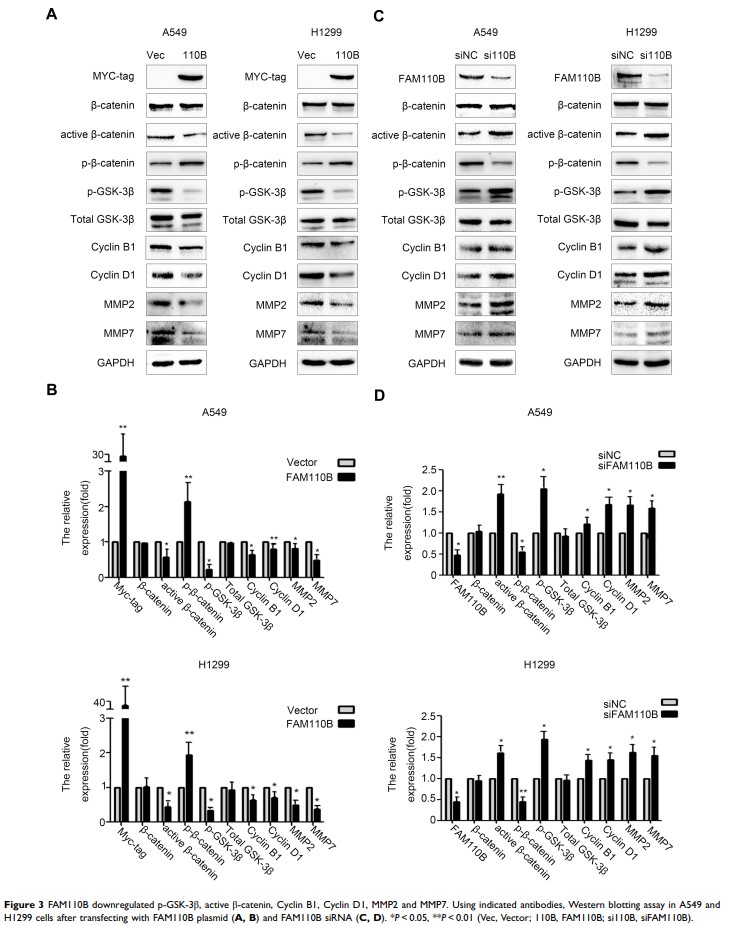9 0 5 7 8
论文已发表
注册即可获取德孚的最新动态
IF 收录期刊
- 2.6 Breast Cancer (Dove Med Press)
- 3.9 Clin Epidemiol
- 3.3 Cancer Manag Res
- 3.9 Infect Drug Resist
- 3.6 Clin Interv Aging
- 4.8 Drug Des Dev Ther
- 2.8 Int J Chronic Obstr
- 8.0 Int J Nanomed
- 2.3 Int J Women's Health
- 3.2 Neuropsych Dis Treat
- 4.0 OncoTargets Ther
- 2.2 Patient Prefer Adher
- 2.8 Ther Clin Risk Manag
- 2.7 J Pain Res
- 3.3 Diabet Metab Synd Ob
- 4.3 Psychol Res Behav Ma
- 3.4 Nat Sci Sleep
- 1.9 Pharmgenomics Pers Med
- 3.5 Risk Manag Healthc Policy
- 4.5 J Inflamm Res
- 2.3 Int J Gen Med
- 4.1 J Hepatocell Carcinoma
- 3.2 J Asthma Allergy
- 2.3 Clin Cosmet Investig Dermatol
- 3.3 J Multidiscip Healthc

FAM110B 通过灭活 WNT/β-连环蛋白信号传导抑制非小细胞肺癌细胞的增殖和侵袭
Authors Xie M, Cai L, Li J, Zhao J, Guo Y, Hou Z, Zhang X, Tian H, Li A, Miao Y
Received 28 January 2020
Accepted for publication 4 May 2020
Published 19 May 2020 Volume 2020:13 Pages 4373—4384
DOI https://doi.org/10.2147/OTT.S247491
Checked for plagiarism Yes
Review by Single-blind
Peer reviewer comments 3
Editor who approved publication: Dr Federico Perche
Purpose: FAM110B is a member of the FAM110 family (family with sequence similarity 110), which is a component of the centrosome associated proteins. Previous studies have shown that FAM110B may be involved in the process of cell cycle and may play a role in carcinogenesis and tumor progression. Using an online database, we found that FAM110B may predict favorable prognosis in non-small cell lung cancer (NSCLC). Therefore, the role of FAM110B playing in NSCLC needs to be further investigated.
Patients and Methods: Online databases and immunohistochemistry were used to predict the expression and prognostic value of FAM110B in NSCLC samples. Immunofluorescence staining was used to investigate the subcellular distribution of FAM110B. Western blot, MTT, colony formation, and matrigel invasion assay were used to detect the expression and the effect of FAM110B on mediating proliferation and invasion in NSCLC cell lines.
Results: In this study, immunohistochemistry results showed that FAM110B expression significantly correlated with early TNM staging (P =0.020) and negative regional lymph node metastasis (P =0.006). Kaplan–Meier survival analysis found that the median survival time of patients with positive FAM110B expression (56.181± 2.348 months) was significantly longer than those with negative FAM110B expression (47.701± 2.997 months, P =0.024). Moreover, overexpression of FAM110B inhibited the proliferation and invasion of A549, H1299, and LK2 cell lines. Conversely, FAM110B RNAi exerted opposite effects in the above cell lines. Furthermore, FAM110B overexpression downregulated the active β‐catenin, phosphorylation of GSK-3β (p-GSK-3β), cyclin B1, cyclin D1, MMP2, and MMP7, and upregulated the phosphorylation of β-catenin (p-β-catenin) in A549 and H1299 cells. Besides, the FAM110B-induced depressions of p-GSK-3β and active β-catenin were reversed after being treated with Wnt/β-catenin inhibitor, XAV-939.
Conclusion: In summary, our results demonstrated that the overexpression of FAM110B restricts the proliferation and invasion of NSCLC cells by inhibiting Wnt/β-catenin signaling. Our study reveals the antitumor function of FAM110B in NSCLC and indicates that FAM110B is a potential therapeutic target.
Keywords: FAM110B, NSCLC, Wnt/β-catenin signaling, proliferation, invasion
